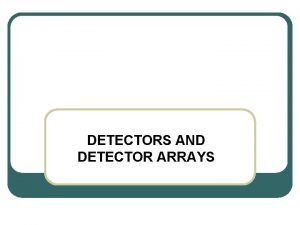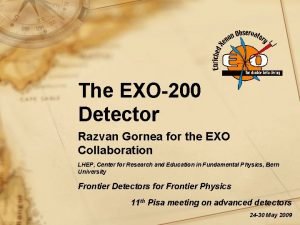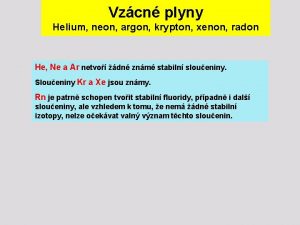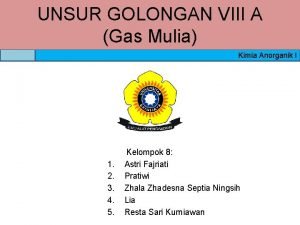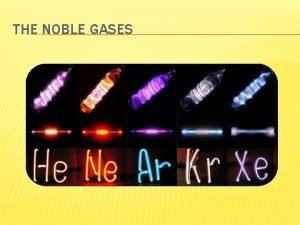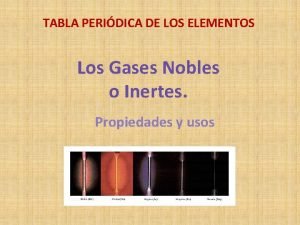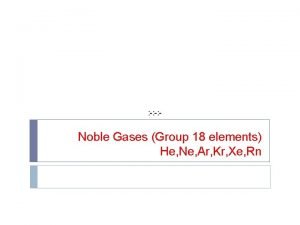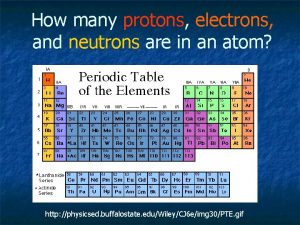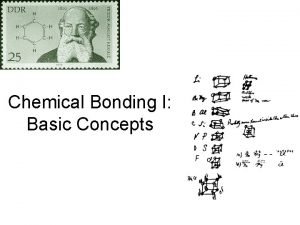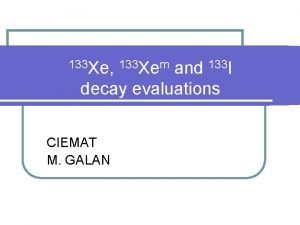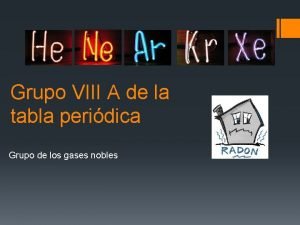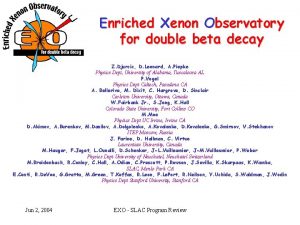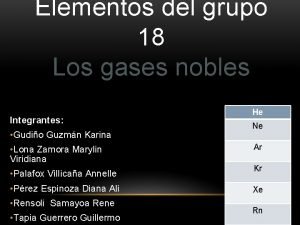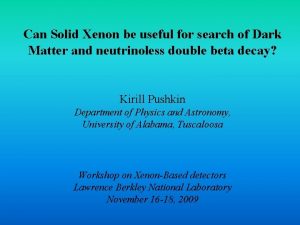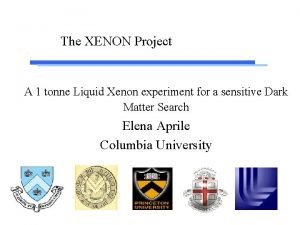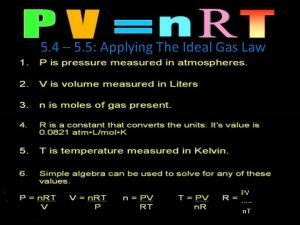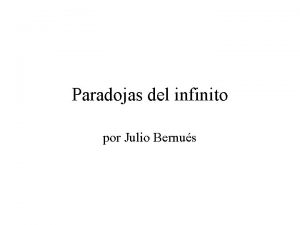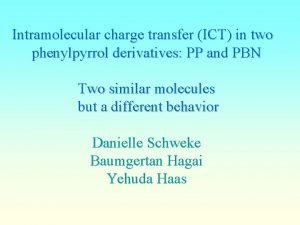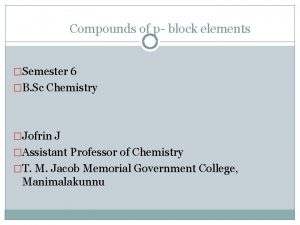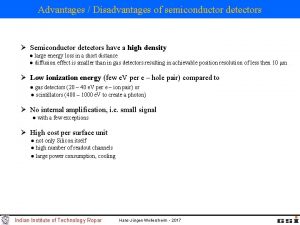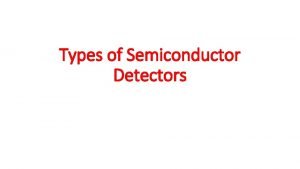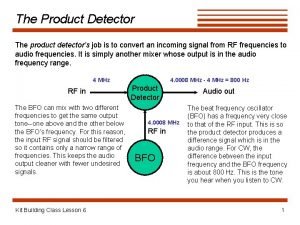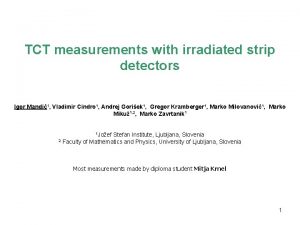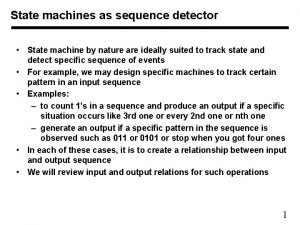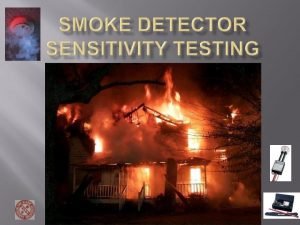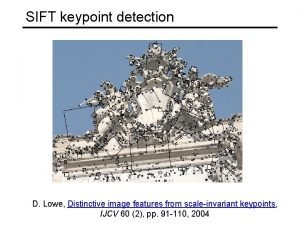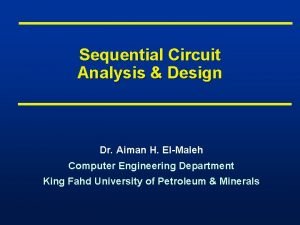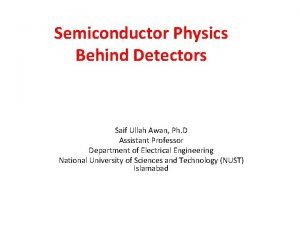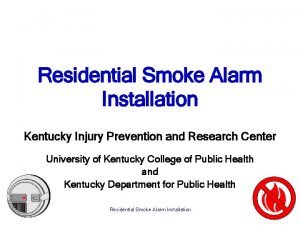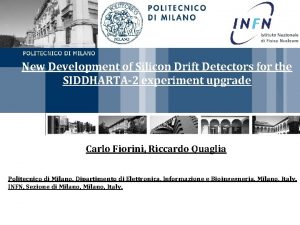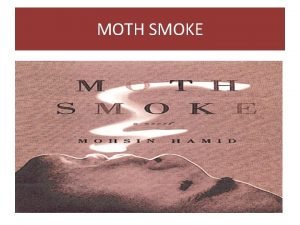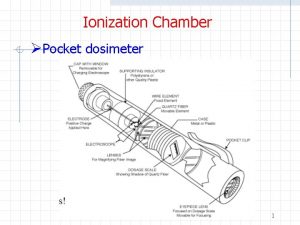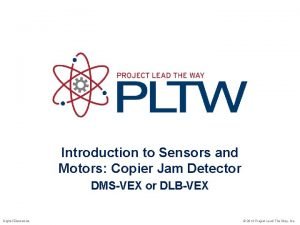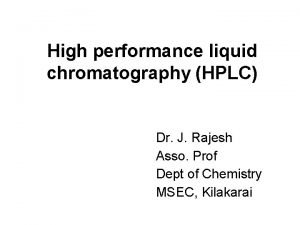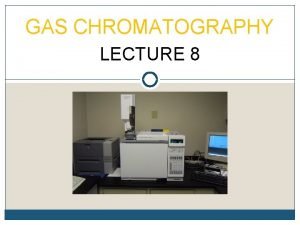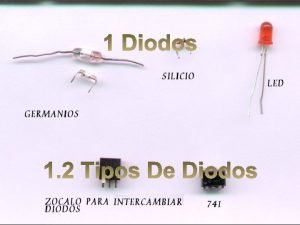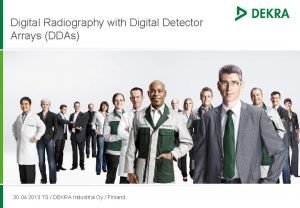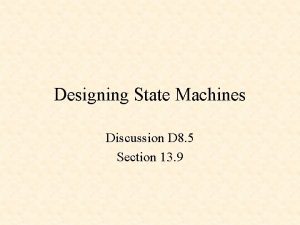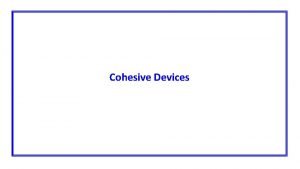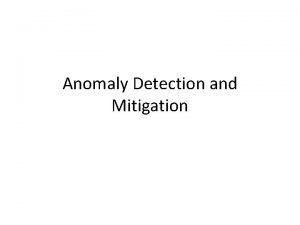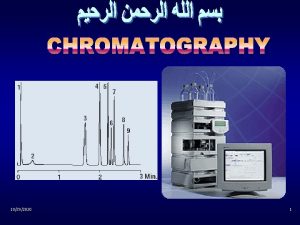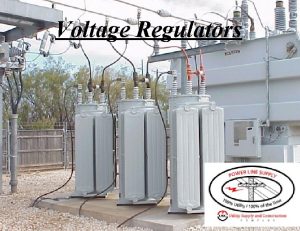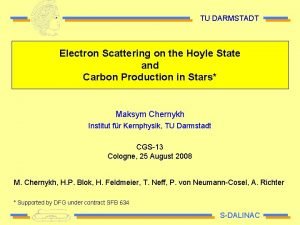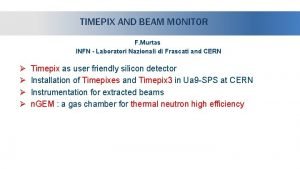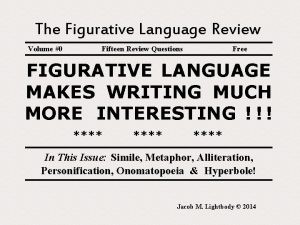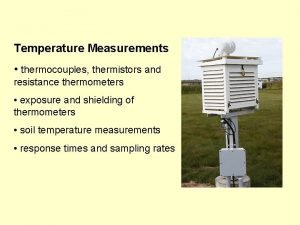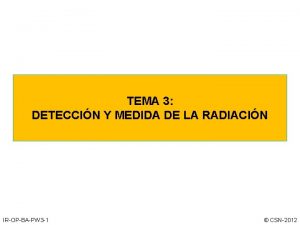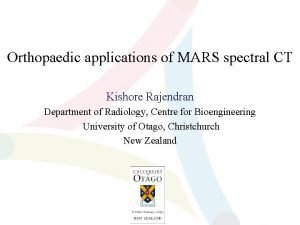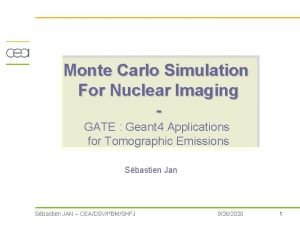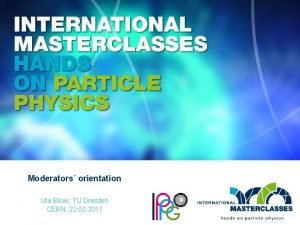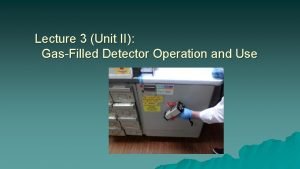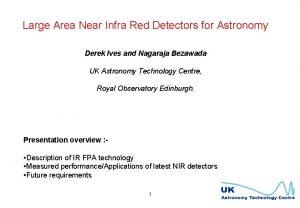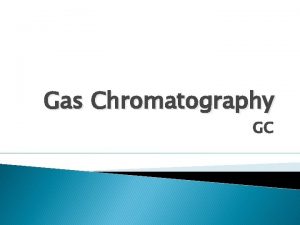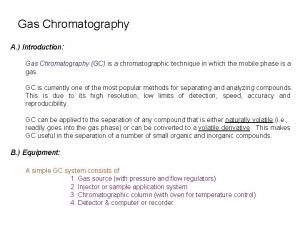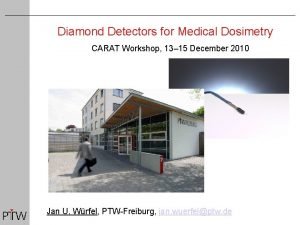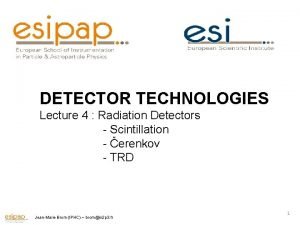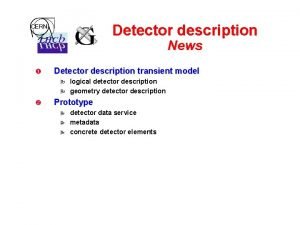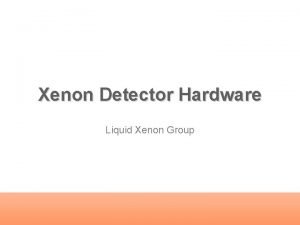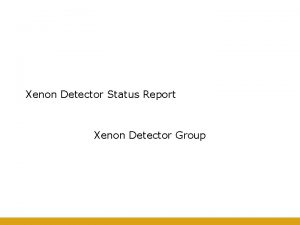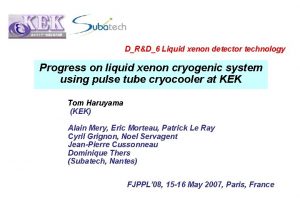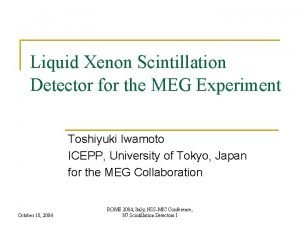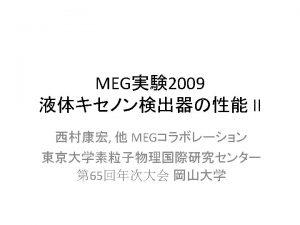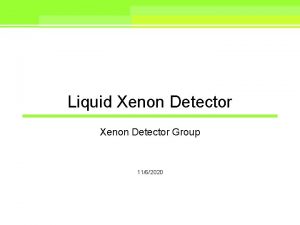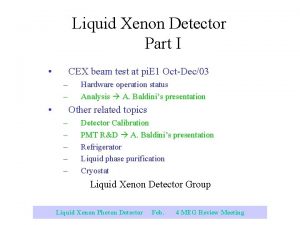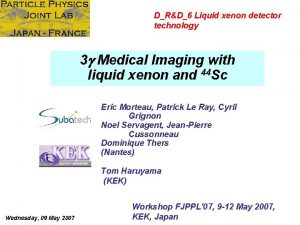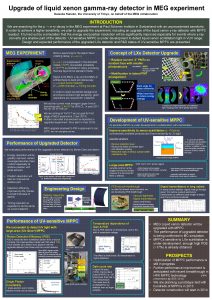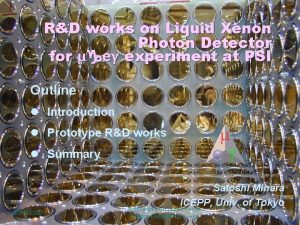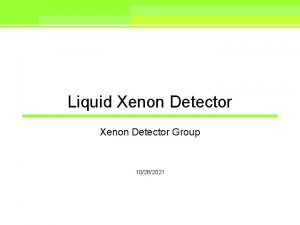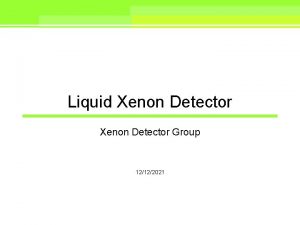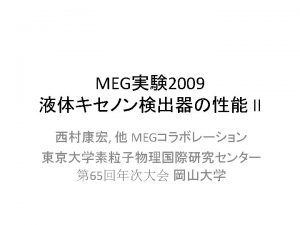Liquid Xenon Detector and Related Topics Liquid Xenon









































































- Slides: 73

Liquid Xenon Detector and Related Topics • • • Liquid Xenon Optical Properties (TN-020) PMT Test Facility TERAS Beam Test Preliminary Results Beam Test in Oct-Dec 03 at PSI Cryostat Schedule S. Mihara For Liquid Xenon Detector Group Satoshi Mihara ICEPP, Univ. of Tokyo July 2003 MEG Review Meeting

LXe optical properties (MEG-TN 020) • The λatt, the VUV λabs and n are not very well known properties for LXe in • Contraddictory measurements contaminations? • Controlled measurements of epsilon, n exist in gas phase: CAN WE EXTRAPOLATE FROM THE GASEOUS TO THE LIQUID PHASE? 1. Yes we can extrapolate give a prediction for n 2. Measurement of λR (LP) measurement of n Satoshi Mihara ICEPP, Univ. of Tokyo July 2003 MEG Review Meeting

Dielectric properties vs density • In gaseous phase: Clausius-Mossotti (Lorentz-Lorenz) • LINEAR IN • At increasing density: non linear effects (virial expansion) !! 2 molecules 3 molecules …. • Molar liquid density = 0. 0229 cm-3 reasonable • Xe is a non polar atom Satoshi Mihara ICEPP, Univ. of Tokyo July 2003 MEG Review Meeting

Check linearity at different wavelengths On the absorption lines the FLL function is only marginally valid but it can be considered an acceptable approximation still at the LXe emission line. . . Satoshi Mihara ICEPP, Univ. of Tokyo July 2003 MEG Review Meeting

A(ω) in VUV gas-liquid. . . as it can be seen directly from the results obtained. A(ω) n = experimental data dilute gas = extrapolated value (fit) Satoshi Mihara ICEPP, Univ. of Tokyo July 2003 MEG Review Meeting

n extrapolation • We can extrapolate a value of n=1. 69 ± 0. 02 at 175 nm • How this compares to published measurements? – Subtil et al. (1987) – Chepel et al. (2002) – Barkov et al. (1996) 1. 71 1. 69 1. 56 (180 nm) • Pretty good agreement Satoshi Mihara ICEPP, Univ. of Tokyo July 2003 MEG Review Meeting

A relation between n and λR • In gaseous phase: • In liquid phase: fluctuations (Einstein equation) • Hence: 8 th power • A measurement of λR gives a hint on n • λR = (29 ± 2) cm* n = (1. 71 ± 0. 015) ! * Ishida et al, NIM A 384 (1997) 380 Satoshi Mihara ICEPP, Univ. of Tokyo July 2003 MEG Review Meeting

PMT Test Facility Satoshi Mihara ICEPP, Univ. of Tokyo July 2003 MEG Review Meeting

MEG – PMT cryogenic test facility: PURPOSES - SYSTEMATIC TEST OF THE PMT’s FOR MEG IN OPERATING CONDITIONS: immersed in liquid Xe - BUILD AN EVOLUTIVE CRYOSTAT: PHASE 1 MANUAL OPERATION WITH LXe EMPTING/FILLING FOR EACH PMT PHASE 2 MANUAL OPERATION WITHOUT LXe EMPTING PHASE 3 TEST OF CARTRIDGE OF PMT’s WITHOUT LXe EMPTING - SETUP A CRYOGENIC LABORATORY AT INFN-PISA - GET EXPERIENCE IN HANDLING LXe - OTHER MEASUREMENTS ON LXe - TESTS ON OTHER PMT’s AND OTHER DEVICES (APD’s, …) FOR THE MOMENT … PHASE 1 Satoshi Mihara ICEPP, Univ. of Tokyo July 2003 MEG Review Meeting

MEG – PMTct – Cryogenic/Vacuum Diagram Phase II Satoshi Mihara ICEPP, Univ. of Tokyo July 2003 MEG Review Meeting

MEG – PMTct - Cryostat Satoshi Mihara ICEPP, Univ. of Tokyo July 2003 MEG Review Meeting

Cryostat delivered from CINEL: phase I… Almost all material delivered: – – Cryostat Pumping system Leak detector Feed-throughs • Signal • Xenon – Gases – Oxisorb – Material for phase 2/3 Waiting for… – Xe transportation tank (needed CE certification) – Clean pipes – Slow control – PMTs! Satoshi Mihara ICEPP, Univ. of Tokyo July 2003 MEG Review Meeting

…and phase II: linear motion and gate valves In phase II/III Xe should be kept liquid: • Gate valve The PMT can be extracted from the top of the cryostat: • Cross • Linear movement attuator Satoshi Mihara ICEPP, Univ. of Tokyo July 2003 MEG Review Meeting

Calibration source and (+LED) 25 mm • -source that is stable in liquid Xenon: – 3 k. Bq 241 Am deposited on a micro-etched surface – Ordered to Campoverde srl. • Quotation from a Czech factory which provides gold-plated sources. • Source and PMT holder under construction • Reference PMT: – Hamamatsu R 7400 -9 Satoshi Mihara ICEPP, Univ. of Tokyo July 2003 MEG Review Meeting

PMT Test Facility Status • The PMT test facilty is close to be operational • Almost all material delivered also for phase II/III • Sources in preparation • In parallel: test at warm temperature. Satoshi Mihara ICEPP, Univ. of Tokyo July 2003 MEG Review Meeting

TERAS BEAM TEST • • Overview of the test Energy measurement Position reconstruction Timing measurement Satoshi Mihara ICEPP, Univ. of Tokyo July 2003 MEG Review Meeting

TERAS beam in April 03 • Xenon liquefaction completed 10 days before the beam time. • Purification of xenon in gas phase. • Data acquisition – 40 Me. V(main), 20 Me. V, 10 Me. V – Different incident positions – Different incident Angles – Materials in front of the detector – PMT high gain runs Satoshi Mihara ICEPP, Univ. of Tokyo July 2003 MEG Review Meeting

Gas Phase Purification System • Xenon extracted from the chamber is purified by passing through the getter. • Purified xenon is returned to the chamber and liquefied again. • Circulation speed 5 -6 cc/minute • Enomoto Micro Pump MX-808 ST-S – 25 liter/m – Teflon, SUS Gas return To purifier Circulation pump Satoshi Mihara ICEPP, Univ. of Tokyo July 2003 MEG Review Meeting

TERAS Beam Line Compton Spectrum • (E -Ec/2)2+(Ec/2)2 • Electron beam – – • Energy: 764 Me. V Energy spread: 0. 48%(sigma) Divergence: <0. 1 mrad(sigma) Beam size: 1. 6 mm(sigma) Collimator size Laser photon – – Energy: 1. 17 e-6 x 4 e. V (for 40 Me. V) Energy spread: 2 x 10 -5 (FWHM) Divergence: unknown Beam size: unknown Satoshi Mihara ICEPP, Univ. of Tokyo July 2003 MEG Review Meeting

MC simulation Short labs D D= Data Previous Test D D: depth parameter D • This Test D D: 20~100 0~25 cm D Long labs Satoshi Mihara ICEPP, Univ. of Tokyo July 2003 MEG Review Meeting

Effect of Material • 5 mmt, 10 mmt, 15 mmt Al • 15 mmt Al+4 mmt Stainless Steel • 5 mmt Pb Al, Stainless, Pb plates LP 2 nd collimator 5 mm Al 10 mm Al 15 mm Al COBRA thickness: 0. 197 X 0 15 mm Al + 4 mm Stainless Stell 5 mmt Pb 0. 053 X 0 0. 11 X 0 0. 16 X 0 0. 398 X 0 0. 89 X 0 Satoshi Mihara ICEPP, Univ. of Tokyo July 2003 MEG Review Meeting

Position/Incident Angle Scan • Incident Position – 10 different positions for 40 Me. V (blue and red) – 2 different positions for 10 Me. V and 20 Me. V (red) • Incident Angle (40 Me. V) – 0, 7. 5, and 15 degree on the center – Not analyzed yet… LP 62 mm Satoshi Mihara ICEPP, Univ. of Tokyo July 2003 MEG Review Meeting

Detector Operation Status • No serious trouble during the test – Except one of two TDC modules was broken in the final run (PMT high gain run) • Total amount of xenon used: ~120 liter • Stable operation by the pulse-tube refrigerator/Liquid Nitrogen cooling pipe (only while circulation) • PMT calibration as usual (LED/alpha/cold gas alpha) Satoshi Mihara ICEPP, Univ. of Tokyo July 2003 MEG Review Meeting

Energy Measurement Satoshi Mihara ICEPP, Univ. of Tokyo July 2003 MEG Review Meeting

Energy Spectrum Fitting • Principle… Compton Spectrum • For understanding simply… Response function E Npe • Suppose Response function is an asymmetric Gaussian s left Convolution of Compton Spectrum Response Function s right Satoshi Mihara ICEPP, Univ. of Tokyo July 2003 MEG Review Meeting

Energy Spectrum Fitting cont’d • Require D(depth parameter)>45 – ~34% of events in the range of 40 Me. V+/-4 Me. V are discarded by this requirement • Suppose Compton Spectrum around the edge (E-Ec/2)2+Ec 2/4 • Detector Response Function – Gaussian with Exponential tail f(x) = Nexp{t/s 2(t/2 -(x-x 0)}, x<x 0+t Nexp{-1/2((x-x 0)/s)2}, x>x 0+t • Convolution – Integration +/- 5 s Detection efficiency (estimated by MC) : 74% within +/- 4% energy cut at 52. 8 Me. V (cf. Progress Report Jul 02) Fitting is done in two steps • Determine the edge position • Fix the edge in the 2 nd fitting for determining the other prams 26 of events are lost due to interaction with (16% % material in front of the active volume) Satoshi Mihara ICEPP, Univ. of Tokyo July 2003 MEG Review Meeting

Dependence on E • Very preliminary – Typical 10, 20, 40 Me. V data fit using the convolution function – Error estimation is not finalized. Conservatively 30% error for the energy resolution is supposed. – Resolution is shown in sigma. Satoshi Mihara ICEPP, Univ. of Tokyo July 2003 MEG Review Meeting

• For incident at the detector center • D > 35, 45, 55…. 85 • Resolution: < 2% in sigma except shallow events (D<45). D Energy Resolution vs. Depth Parameter Number of Photoelectrons Satoshi Mihara ICEPP, Univ. of Tokyo July 2003 MEG Review Meeting

Material Effect on the Resolution • No apparent deterioration of the resolution • Loss of efficiency Al 5 mm Pb 5 mm Trigger Threshold COBRA Thickness Satoshi Mihara ICEPP, Univ. of Tokyo July 2003 MEG Review Meeting

Position Dependence 1. 85% in s 1. 83% in s 1. 80% in s Satoshi Mihara ICEPP, Univ. of Tokyo July 2003 MEG Review Meeting

Measurement with half the front PMT switched off • To simulate the convex front geometry of the cryostat • MC simulation (reported in the last review meeting) • TERAS data – Switch off half of the PMTs in the front face Use 4 x 4 PMTs out of 6 x 6 PMTs – Switch off PMTs on the side walls Satoshi Mihara ICEPP, Univ. of Tokyo July 2003 MEG Review Meeting

VLP and Curved Detector Shape studies: Compare Li. Xe and a VLP (100 x 50 cm 3) to check the effects of a different geometry on position and energy resolution. • no difference with the curved detector for position resolution (10. 6 mm FWHM in both cases for a realistic situation); a 3% systematic correction is needed on both coordinates for VLP • slight improvement in energy resolution (from 4% to 3. 5%); • however, more critical problems of energy containment a much larger volume (1. 5 m 3) of Xenon would be needed (and PMTs!). Satoshi Mihara ICEPP, Univ. of Tokyo July 2003 MEG Review Meeting

TERAS Data • Only 4 x 4 PMTs on the front face Switching off half the front PMTs – Compton Edge shifts by 6. 2% – Resolutions are almost same (1. 84 to 1. 85% in s) before and after switching off. • Switching off PMTs on the side wall(s) – 1 plane off 2. 05% in s – 2 planes off 2. 22% in s – 3, 4 planes off > 3% in s Number of Photoelectrons 4 planes off 1/Npe 3 planes off 2 planes off 1/sqrt(Npe) 1 plane off Satoshi Mihara ICEPP, Univ. of Tokyo July 2003 MEG Review Meeting

D Switching off PMTs on side walls 1 plane off • Deterioration of the energy resolution when switching off PMTs is not mainly caused by loss of Npe. • PMTs on the side walls compensate 1 st conversion point dependence. D Number of Photoelectrons 3 planes off Number of Photoelectrons Satoshi Mihara ICEPP, Univ. of Tokyo July 2003 MEG Review Meeting

Effect of a “faulty” PMT • All PMTs on: s=1. 8% • Switching off one PMT on the front wall. F 30 off – the nearest PMT s=2. 3% – 2 nd nearest PMT s=1. 9% – 3 rd nearest PMT s=1. 9% s=2. 3% • 300 PMTs on the front face in the final detector F 22 off F 28 off s=1. 9% – ~4/300 = 1. 3% loss of acceptance Satoshi Mihara ICEPP, Univ. of Tokyo July 2003 MEG Review Meeting

Position Reconstruction • Simple weighted average – Using all PMTs on the front – Very fast, but not so good resolution and “bias” exits • Localized weight method – Using only selected PMTs around the energy release points to reduce the shower fluctuation effect Satoshi Mihara ICEPP, Univ. of Tokyo July 2003 MEG Review Meeting

Simple Average Method Depth • Data and MC are in good agreement. • Reconstruction “bias” exists. Satoshi Mihara ICEPP, Univ. of Tokyo July 2003 MEG Review Meeting

Localized Weight Method • Projection to x and y directions. • Peak point and distribution spread • Position reconstruction using the selected PMT Satoshi Mihara ICEPP, Univ. of Tokyo July 2003 MEG Review Meeting

Samples of Reconstruction 1 mm Satoshi Mihara ICEPP, Univ. of Tokyo July 2003 MEG Review Meeting

Reconstruction “Bias” Satoshi Mihara ICEPP, Univ. of Tokyo July 2003 MEG Review Meeting

Position Reconstruction Resolution Satoshi Mihara ICEPP, Univ. of Tokyo July 2003 MEG Review Meeting

Timing Measurement • 128 TDC channels for the PMTs around the front face. • Leading-edge discriminator with threshold level at – 12 m. V. • Start timing of the TDCs is • Same method as in KSR determined by the xenon electron beam test is employed detector itself. for timing measurement. – Laser start timing 1 s jitter. – Electron tagging counter was placed in a TERAS Q-magnet. Difficult to achieve good resolution as a reference. • Detector is divided to left and right groups and arrival time difference was compared to evaluate the resolution. Satoshi Mihara ICEPP, Univ. of Tokyo July 2003 MEG Review Meeting

Timing Measurement Very Preliminary Result We observed that 1. Timing resolution improves as the PMT gain increases. 2. Timing resolution improves as Npe increases. – The best value (48. 8 psec in sigma) was obtained for >160 Me. V synchrotron radiation light taken in a dedicated run Left Effect of shower fluctuation along the incident direction is canceled, while the effect perpendicular to it is not. Right Satoshi Mihara ICEPP, Univ. of Tokyo July 2003 MEG Review Meeting

Open Questions • Compton Spectrum Shape – Broader than simulated shape – Detector effect ? • Reflection or absorption on the PMT window? • Rate Dependence Satoshi Mihara ICEPP, Univ. of Tokyo July 2003 MEG Review Meeting

Compton Spectrum Shape 1. 2. Broad peak of the total photoelectrons. Many low energy events. Maybe beam spectrum We have not a clear answer threshold Satoshi Mihara ICEPP, Univ. of Tokyo July 2003 MEG Review Meeting

Comparison with revised MC a t Compton spectrum shape a D • Electron beam spread at the collision point • Collimator position Satoshi Mihara ICEPP, Univ. of Tokyo July 2003 MEG Review Meeting M C

Reflection or Absorption on the PMT window? (Qsum-Qfront)/Qsum D Qsum Satoshi Mihara ICEPP, Univ. of Tokyo July 2003 MEG Review Meeting

Discrepancy at Low Energy Side a t a D z<0 M C 0<z<3 total photoelectrons z: first conversion depth [cm] , 0 means surface of LXe. Satoshi Mihara ICEPP, Univ. of Tokyo July 2003 MEG Review Meeting

Rate Dependence LED • Rate dependence – In case of high current in TERAS, SR light background is huge to decrease the effective gain of the PMTs. – Data with a 60 Co source in front of the entrance wall at different distance to simulate background. • Detailed analysis to interpret the measured dependence for the actual detector operating condition is not finished yet… Satoshi Mihara ICEPP, Univ. of Tokyo July 2003 MEG Review Meeting

Oct-Dec 03 Beam Test at E 1 Satoshi Mihara ICEPP, Univ. of Tokyo July 2003 MEG Review Meeting

The elementary process - (essentially) at rest captured on protons: - p 0 n - p n 0 Photon spectrum 54. 9 82. 9 129 Me. V Satoshi Mihara ICEPP, Univ. of Tokyo July 2003 MEG Review Meeting

CM and Lab frame M /2(1 cos *) * M /2 E =55 Me. V * = Satoshi Mihara ICEPP, Univ. of Tokyo July 2003 MEG Review Meeting

Angular selection • ’s back to back in lab: 55 and 84 Me. V • E / E < 1% < 5 o 5 o = 87 mrad = 8. 7 cm @1 m • This fixes the angular acceptance to 6 10 -4 /56* = 1. 07 10 -5 - *(83 -55)/0. 5 Satoshi Mihara ICEPP, Univ. of Tokyo July 2003 MEG Review Meeting

Experimental configuration TARGET? • Rate Na. I • Background • Thin/small (angle/X 0) -- beam C Mod • Handling TA Previous use • GH 2 (Panofsky…. ) Coincidence: C & !A & Na. I (Offline: & LXe) LXe • LH 2 (PIBETA) • CH 2 (MEGA) • Li. H ( e at SIN) Satoshi Mihara ICEPP, Univ. of Tokyo July 2003 MEG Review Meeting

CH 2 target(1) • Easy to handle • Active (scintillator) but. . . • Capture rate on Carbon ~1300 capture rate on protons (s-wave capture Z 4) rate suppression by factor 650 • Range R p 3 a few cm R/R~(200 me /m )1/2 f(E/m ) (Segre’, Ritson, Rossi) ~3. 5% OK • Background? Satoshi Mihara ICEPP, Univ. of Tokyo July 2003 MEG Review Meeting

Applied in MEGA • A CH 2 calibration target was used in MEGA 3. 3%FWHM 5. 7%FWHM • The BKG “from - c-ex in flight is visible in the low energy tail” • Could be measured (graphite target) and subtracted Satoshi Mihara ICEPP, Univ. of Tokyo July 2003 MEG Review Meeting

Hydrogen target • The most “natural” choice LH 2 • = 0. 071 g/cm 3 • Range: p = 80 Me. V/c R 14 cm, R 0. 5 cm 110 Me. V/c R 41 cm, R 1. 4 cm • Already available GH 2 • = 6. 7 10 -3 g/cm 3 • Range: p = 80 Me. V/c R 150 cm, R 5. 6 cm 110 Me. V/c R 450 cm, R 15 cm Satoshi Mihara ICEPP, Univ. of Tokyo July 2003 MEG Review Meeting

Rate • dp/p up to 0. 8% FWHM • - flux ~ 8· 105/s at 1. 6 m. A Satoshi Mihara ICEPP, Univ. of Tokyo July 2003 MEG Review Meeting

1999 measurement 10%FWHM • D=100 cm • 10 x 10 window • 9. 5 hours • no light in LYSO • 60 cm (Na. I) 75 cm (Cs. I) • 11 x 13 window Satoshi Mihara ICEPP, Univ. of Tokyo July 2003 MEG Review Meeting

Cryostat Design Satoshi Mihara ICEPP, Univ. of Tokyo July 2003 MEG Review Meeting

Cryostat • Fabrizio Raffaelli has joined the design/construction group for the cryostat. • All information can be found at http: //meg. psi. ch subproject calorimeter Design and Construction… Satoshi Mihara ICEPP, Univ. of Tokyo July 2003 MEG Review Meeting

Thickness of the Walls/Covers • Suppose the pressure tolerance of 0. 3 MPa for the inner vessel and 0. 1 MPa for the outer vessel (vacuum insulation layer). Satoshi Mihara ICEPP, Univ. of Tokyo July 2003 MEG Review Meeting

Stress Distribution Satoshi Mihara ICEPP, Univ. of Tokyo July 2003 MEG Review Meeting

Deformation Satoshi Mihara ICEPP, Univ. of Tokyo July 2003 MEG Review Meeting

Strength Calculation for the G 10 Support and the Brace Satoshi Mihara ICEPP, Univ. of Tokyo July 2003 MEG Review Meeting

Heat Load Calculation • See also T. Haruyama’s talk on Jul 2002 review meeting. • Main contribution is from PMT and cables. • One pulse tube refrigerator can compensate the load. Satoshi Mihara ICEPP, Univ. of Tokyo July 2003 MEG Review Meeting

Metal gasket for the inner vessel flanges • One possible manufacture (in Japan) is USUI. – Usage condition • • Pressure: 0 - 0. 3 MPa Temperature: -110 ~ 100 degree C Fluid: Liquid xenon Flange and bolt: SUS 316 L Cover Flange – U-tight seal dimension • Cross section: 5. 5 mm diam • Material: Aluminum(outer), Stainless(Inner), Spring(Inconel) Special Shape We need a mold for casting. Satoshi Mihara ICEPP, Univ. of Tokyo July 2003 MEG Review Meeting

T. Haruyama’s talk on Jul 2002 review meeting Satoshi Mihara ICEPP, Univ. of Tokyo July 2003 MEG Review Meeting

Operation Scheme T. Haruyama’s talk on Jul 2002 review meeting Satoshi Mihara ICEPP, Univ. of Tokyo July 2003 MEG Review Meeting

Some questions and remarks after seeing the Cryostat drawings by Fabrizio Raffaelli • • • Which is the design pressure for the inner vessel ? Is the testing procedure has been already studied during the fabrication steps and which are the final acceptance tests? Is the safety has been already studied? The of safety relief devices are already implemented? For instance if there is a xenon leak into the vacuum the pressure on the outer vessel can increase more than 1 atm. Is the cold sealing has been already chosen and which are the specification for the groove accuracy ? Is the cold window has been already studied ? The pre-cooling system is already implemented in the inner vessel but its efficiency is already studied? Is an heating system has been considered to empty the inner vessel? Which are the envisaged mounting steps? Which adjustments are envisaged to position the Inner vessel in cold condition ? A lot of other questions will raise going in the drawing details. Satoshi Mihara ICEPP, Univ. of Tokyo July 2003 MEG Review Meeting

Remarks after seeing the drawings: by Fabrizio Raffaelli Covers: • I see that the polished area of the sealing surface is not protected and it is not well localized from the point of view of machining operations and further hands polished operation. • The inner vessel flange is quite slim (30 mm) and I am worry that after the welding with the I. V. body we are not able to guarantee the necessary flatness. I think we need to study the technological construction step and may be weld a long collar before machining the flange. • Since the shape of the cover is not simple the oring especially the cold one should be custum made and I think will require a mold. Satoshi Mihara ICEPP, Univ. of Tokyo July 2003 MEG Review Meeting

Photon Detector 2002 Large Prototype 2003 Beam Test 2004 Beam Test Vessel Design Refrigerator Engineering runs Manufactoring PMT Delivery + Testing Manufactoring 2005 Assembly & Test Assembly Liq. Purification Manufactoring Test. Meeting Milestone Satoshi Mihara ICEPP, Univ. Design of Tokyo July 2003 Assembly MEG Review

Summary • Liquid Xenon optical properties (TN-020). • PMT test facility (Phase I) is close to be operational. • TERAS beam test results – Energy Resolution at 40 Me. V ~2% in sigma – Needs more careful analysis to treat shallow events • Large Prototype beam test at E 1 in Oct-Dec 03. – CH 2, GH 2, LH 2 • Cryostat design will be finalized in 2003. Satoshi Mihara ICEPP, Univ. of Tokyo July 2003 MEG Review Meeting
 Xenon gas detector in ct
Xenon gas detector in ct Razvan gornea
Razvan gornea The integration of eye, hand, and foot movements
The integration of eye, hand, and foot movements Skill related fitness vs health related fitness
Skill related fitness vs health related fitness Liquids dielectrics are mainly used as
Liquids dielectrics are mainly used as Sieve tray tower
Sieve tray tower Helium neon argon krypton xenon
Helium neon argon krypton xenon Proses pembuatan kripton
Proses pembuatan kripton Xenon chemical properties
Xenon chemical properties Propiedades del neón
Propiedades del neón 18 group elements
18 group elements Http //education.jlab.org/qa/pen number.html
Http //education.jlab.org/qa/pen number.html What atoms can have an expanded octet
What atoms can have an expanded octet Xenon 133 decay
Xenon 133 decay In an industrial process nitrogen is heated to 500k
In an industrial process nitrogen is heated to 500k Rd xenon
Rd xenon Xenón grupo
Xenón grupo Xenon decay
Xenon decay Xenón grupo
Xenón grupo Solid xenon
Solid xenon Xenon project
Xenon project Calculate the density of xenon gas at a pressure of 742
Calculate the density of xenon gas at a pressure of 742 Xenon cos leaked
Xenon cos leaked Paradoja del hotel infinito
Paradoja del hotel infinito Xenon matrix 2
Xenon matrix 2 Electrolysis of molten icl liberates i2 at
Electrolysis of molten icl liberates i2 at Disadvantages of semiconductor detector
Disadvantages of semiconductor detector Detector building science olympiad cheat sheet
Detector building science olympiad cheat sheet Diffused junction detector
Diffused junction detector What is a product detector
What is a product detector Spaghetti detector
Spaghetti detector Sequence detector examples
Sequence detector examples Walter jaeger smoke detector
Walter jaeger smoke detector Sift keypoint detector
Sift keypoint detector Sequence detector 1101
Sequence detector 1101 Disadvantages of semiconductor detector
Disadvantages of semiconductor detector Cci controls lp gas detector
Cci controls lp gas detector Smoke detector installation kentucky
Smoke detector installation kentucky Autoplágio o que é
Autoplágio o que é Silicon drift detector explained
Silicon drift detector explained Moth smoke detector
Moth smoke detector Detectors used in hplc
Detectors used in hplc Pocket ion chamber
Pocket ion chamber Dlb dms
Dlb dms Advantages of hplc
Advantages of hplc Kjustk
Kjustk Gas-liquid chromatography
Gas-liquid chromatography Moravec detector
Moravec detector Diodo schottky definicion
Diodo schottky definicion Digital detector array
Digital detector array 1101 sequence detector using mealy
1101 sequence detector using mealy Whereas cohesive devices
Whereas cohesive devices Argus lighting
Argus lighting Cisco anomaly detector
Cisco anomaly detector Hplc detector types
Hplc detector types Regulator neutral detector
Regulator neutral detector Color code detector
Color code detector Timepix detector
Timepix detector Silicon drift detector principle
Silicon drift detector principle Figurative language detector
Figurative language detector Colour code detector
Colour code detector Thermal conductivity detector
Thermal conductivity detector Detector de ionización gaseosa
Detector de ionización gaseosa Rdg packer detector
Rdg packer detector Ct scan detector
Ct scan detector Ct scan detector
Ct scan detector Uni dresden
Uni dresden Cutie pie detector
Cutie pie detector Ir detector
Ir detector Thermal conductivity detector
Thermal conductivity detector Flame ionization detector
Flame ionization detector Ptw diamond detector
Ptw diamond detector Hpdcms
Hpdcms Logical fallacies detector
Logical fallacies detector
